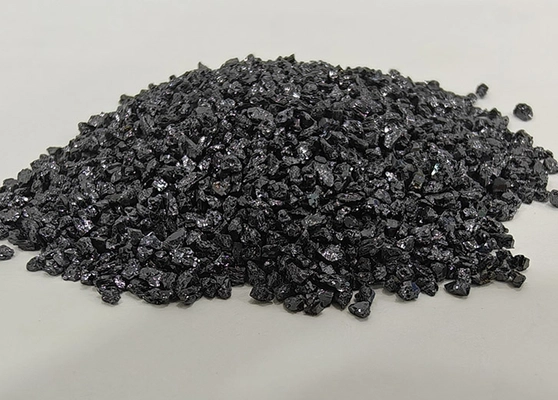Quick Answer: Carborundum crystal, also known as silicon carbide (SiC), is a synthetic compound of silicon and carbon with exceptional hardness (Mohs 9–9.5), high thermal conductivity, and excellent chemical stability. It’s widely used in abrasives, refractories, ceramics, and semiconductor industries.
Table of Contents
- Introduction to Carborundum Crystal
- Properties of Carborundum Crystal
- Applications and Industrial Uses
- Innovations in Manufacturing
- FAQ
Introduction to Carborundum Crystal
Carborundum crystal is a synthetic compound made from silicon and carbon. Unlike conventional black or green silicon carbide, carborundum crystal often displays vibrant rainbow colors due to optical interference from impurities and crystal structure variations. This striking appearance has earned it the nickname “rainbow carborundum.”
Properties of Carborundum Crystal
Physical Properties
- Hardness: Mohs 9–9.5, just below diamond.
- Crystal Structure: Exists in α-SiC (hexagonal/rhombohedral) and β-SiC (cubic) forms.
- Density: Around 3.21 g/cm³.
- Melting Point: Approximately 2,700°C (4,892°F).
- Thermal Conductivity: 120–200 W/(m·K).
- Thermal Expansion Coefficient: 4.0–5.6 × 10⁻⁶ /°C.
- Electrical Conductivity: Ranges from insulating to semiconductive, depending on doping.
- Color: Black, green, yellow, or rainbow depending on impurities.
- Wear Resistance: Outstanding resistance against abrasion and corrosion.
Chemical Properties
- Chemical Stability: Highly inert and stable under most environments.
- Oxidation Resistance: Forms a protective silica layer at high temperatures.
- Corrosion Resistance: Resists acids, alkalis, and molten metals.
- Thermal Decomposition: Begins above 2,300°C in inert conditions.
- Electrical and Photonic Properties: Doping can modify conductivity; used in LEDs and photodetectors.
Applications and Industrial Uses
1. Abrasive Industry
Carborundum crystal is used as an abrasive in grinding wheels, sandblasting media, and cutting tools for metal, ceramics, and plastics. Its hardness and sharp edges provide superior grinding efficiency and durability.
2. Refractory Materials
Due to its high melting point and thermal stability, silicon carbide crystal is ideal for high-temperature furnace linings, kiln furniture, and crucibles in the metallurgical and glass industries.
3. Advanced Ceramics
Used in advanced ceramic applications such as armor plates, high-performance brakes, and heat exchangers where mechanical strength and thermal shock resistance are critical.
4. Semiconductor Applications
- Power electronic devices (SiC MOSFETs, diodes)
- Electric vehicle power systems
- Solar inverters and charging stations
- LED lighting and optoelectronics
Innovations in Carborundum Crystal Manufacturing
3D Printing with Silicon Carbide
SiC-based 3D printing is an emerging technology that allows rapid prototyping of heat-resistant parts, reducing production lead times and enabling complex designs in refractory and aerospace components.
Physical Vapor Transport (PVT)
The PVT (sublimation) method refines SiC crystal growth by sublimating SiC powder and recrystallizing it onto seed crystals at controlled temperatures. Recent innovations in temperature gradients and pressure control have led to larger, high-purity SiC single crystals with minimal defects.
Carborundum Crystal from CanAbrasive
CanAbrasive specializes in supplying high-purity silicon carbide materials for both industrial and scientific applications. Our SiC abrasives are manufactured under strict quality control and are available in black and green grades, covering macrogrits, microgrits, and powders suitable for polishing, grinding, and refractory production.
Contact our team to request detailed TDS, MSDS, and customized specifications for your application needs.
Conclusion
Carborundum crystal symbolizes the evolution of materials science — combining strength, heat resistance, and electrical versatility. From heavy-duty abrasives to next-generation semiconductors, its role continues to expand, driving progress across industries worldwide.
FAQ: Carborundum Crystal
What is carborundum crystal made of?
It is made from silicon and carbon, forming silicon carbide (SiC) through high-temperature reaction.
What is the difference between carborundum crystal and regular silicon carbide?
Structurally they are the same compound (SiC), but carborundum crystal often refers to larger, colorful or decorative crystals rather than industrial grains.
Where is carborundum crystal used?
It’s used in abrasives, refractory linings, ceramics, semiconductor devices, and high-tech applications like EV power modules.
Is carborundum crystal natural or synthetic?
It is synthetic. Natural SiC (moissanite) is extremely rare, so almost all carborundum is man-made.
Request a Quote or Sample
Popular Products
Grünes Siliziumkarbid
View DetailsSchwarzes Siliziumkarbid
View Details